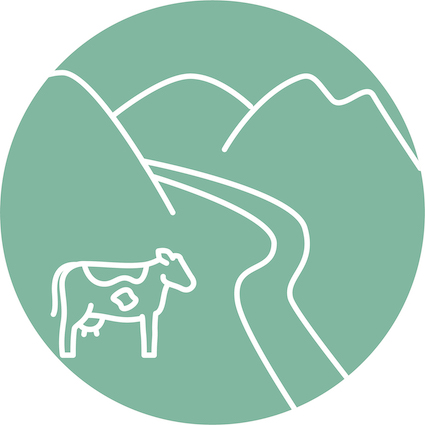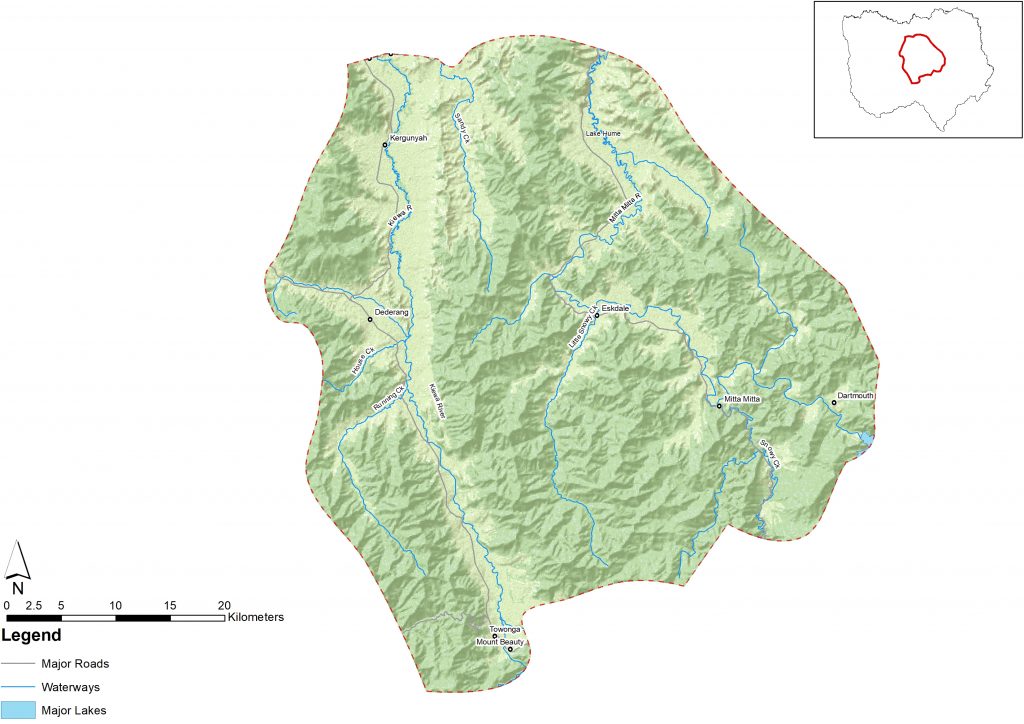
Vision
Sustainable land management and recreation thriving alongside healthy forested mountains and waterways
Introduction
A combination of mountain landscapes – usually public land – and cleared valley floors, utilised mainly for agriculture.
The landscape remains significant for Traditional Owners/First Nations Peoples. Much of the cultural heritage and country remains intact due to the large areas of public land.
Regional towns include Kiewa, Tawonga, Dederang, Mt Beauty. The area has an ageing population, is experiencing population decline and has low economic diversity with a high dependence on agriculture, mainly beef and dairy.

What is important?
Important attributes
Important attributes of this landscape identified by those who live, work, visit or connect with this landscape include:
- The Kiewa River valley supports significant dairy farming, including some irrigated pasture
- Significant areas for recreational fishing, boating, swimming, and waterside activities such as walking and camping
- Mitta Mitta River is a premier fishing, canoeing and rafting location, providing challenging white water and an attractive river environment
- Strong tourism industry in the Kiewa valley especially mountain biking and culinary experiences
- Establishment of agricultural cooperatives supporting farming business in turbulent markets, particularly the dairy industry.
Key features
| Theme | Key features |
|---|---|
| Land | Fertile valley floors cleared for agriculture and rich pastures. Mt Big Ben (1158m). Native perennial pastures are a key feature in this landscape. The lower reaches of the valley are wider and offer spectacular views of the rolling landscape. The Mitta Valley is heritage-listed, due to its outstanding historical and cultural significance. |
| Water | The two major tributaries are the Mitta Mitta River and the Kiewa River. Both systems flow into Lake Hume. The Kiewa River begins between Mt Bogong and Mt Hotham as two main branches, the East and West Branches, which join below Mount Beauty. Major tributaries of the Kiewa River include Mountain Creek, Running Creek and Yackandandah Creek. The Mount Beauty Pondage is part of the Kiewa Hydro-electric Scheme used to regulate flows into the Kiewa River. Snowy Creek is the major tributary of the Mitta Mitta River. Other tributaries include Little Snowy Creek, Fairyknowe Creek and Little Scrubby Creek, which run through predominantly agricultural landscapes downstream of Mitta Mitta. The Lower Mitta Mitta River has cold water flows and a mainly cobble/gravel substrate. The Kergunyah wetlands is an important ecosystem in this landscape, comprising 2.65 ha and 90% native vegetation cover. |
| Biodiversity | Stands or remnant patches of significant vegetation can be found along most parts of the waterways and across agricultural lands. Alpine sphagnum bogs and associated fens are found within the Kiewa Corridor. Inland slopes forests and woodlands have high amenity values within fragmented rural landscapes. The large older trees (sometimes single paddock trees) are noteworthy for landscape connectivity. High priority threatened migratory fish (e.g. Murray cod and golden perch) are found in the Kiewa River upstream of Running Creek. Some important species and communities: Flora Sparse riparian vegetation includes Plains Grassy Woodlands and Floodplain Riparian woodlands, with remnants of hollow-bearing trees. Terrestrial fauna Greater glider (Petauroides volans) Eastern pygmy-possum (Cercartetus nanus) Speckled warbler (Chthonicola sagittatus) Bush-stone curlew (Burhinus grallarius) Aquatic/riparian/wetland fauna Platypus (Ornithorhynchus anatinus) Azure kingfisher (Ceyx azureus) Nankeen night heron (Nycticorax caledonicus) Growling grass frog (Litoria raniformis) Macquarie perch (Macquaria australasica) Murray cod (Maccullochella peelii) Golden perch (Macquaria ambigua) Trout cod (Maccullochella macquariensis) Smooth toadlet (Uperoleia laevigata) |
| Community | Regional towns and villages include Eskdale, Mitta Mitta, Mt Beauty, Tawonga and Dederang. Community involvement in the system is strong, with many active community groups engaged in supporting NRM. Evidence of Traditional Owners/First Nations Peoples use remains with scar trees and artefacts scattered along waterways. Education is the main industry of employment in the townships of Mt Beauty and Tawonga South. Mountain-based amenity is an important economic and lifestyle value. |
Condition
The following is a snapshot of condition for the Central Mountain Landscape.
| Land | The Kiewa River below Mt Beauty has a flat floodplain affected by sedimentation and constructed levees, typical of a river valley used extensively for grazing and agricultural pursuits. High risk of soil acidification along the Kiewa and Mitta valleys where land clearing has occurred. Soil carbon stocks are generally steady with potential for increases under current or altered land management. |
| Water | Tributaries have reduced summer low flows due to extractions for urban, rural and stock purposes. The Kiewa River East branch is heavily regulated from Clover Pondage and Lake Guy to deliver water to a series of hydro-electric power stations. The West Branch is relatively unregulated and flows in a narrow valley until it is diverted into the hydro-electric power system. Hydro-electricity power station demands are altering waterways causing harm to ecosystems in the East and West Kiewa tributaries. The Kiewa River is considered in moderate condition while its smaller tributaries are in excellent condition.[54] The Lower Mitta Mitta River is highly regulated to transfer water for users downstream of Lake Hume. Significant waterway improvement works are undertaken to manage the impact of this water transfer. Mitta Mitta River is in ‘very poor condition’ upstream of Little Snowy Creek and improves slightly to ‘poor condition’ downstream of this confluence.[55] Effluent and nutrient run-off from dairy operations is likely to affect water quality at some locations throughout the landscape. In-stream woody habitat in the Mitta Mitta and Kiewa system is mostly in natural condition with scattered stretches of moderately depleted habitat in the lower reaches. Sandy Creek has a highly to severely depleted in-stream woody habitat.[56] |
| Biodiversity | Areas of largely intact forests and woodlands on slopes within fragmented rural landscapes with some remnant vegetation. The Mitta Mitta River provides habitat for one of the largest naturally occurring population of Macquarie perch in Victoria. Bird species changing as native species decline – the speckled warbler (Chthonicola sagittatus), for example, is a threatened woodland species in decline across the landscape. The greater glider (Petauroides volans) is threatened, with evidence of decline across its range including this landscape. The species is hollow-dependent, and loss of habitat is a significant threat to its survival. The condition of frog species, including the vulnerable growling grass frog (Litoria raniformis), is susceptible to the spread of chytridiomycosis (chytrid fungus disease). The macroinvertebrate communities in the Snowy Creek catchment are generally in excellent condition, as is the riparian vegetation.[57] The macroinvertebrate community is in good to excellent condition in many reaches but is relatively poor in the lower parts of three tributaries (Middle Creek, Yackandandah Creek and Running Creek).[58] The native fish communities in the Mitta Mitta River main stem and tributaries contain many of the species expected, but diversity is restricted primarily due to river regulation.[59] The condition of the riparian vegetation is good to excellent in the upper reaches but declining, with distance, downstream.[60] |
| Community/ socio-economic | Lower reaches of this landscape are being impacted by development expanding from the Wodonga area. Most communities are dependent upon agriculture, notably the beef and dairy industry. There is low economic diversity throughout the landscape. The population is ageing and population declining.[61] High land values in the upper Kiewa are shifting agriculture towards more intensive small-scale horticulture, gourmet produce and farm visitation.[62] The population has a higher proportion with no tertiary education, greater employment in blue collar industries and lower median incomes than other areas in north east Victoria. Multiculturalism and diversity are lowest in Mt Beauty and Kiewa Valley, while Mitta Mitta Valley has a slight increase in non-English language spoken in the home and being born overseas. |
What is changing?
The world and our region are changing rapidly and north east Victoria is more interconnected across multiple spatial scales than ever before. This section describes the major drivers of change and what this means for the Central Mountain Valley landscape.
Drivers of change
| Driver of change | Leading to |
| Climate change and acute shocks and extreme events | Extreme weather events such as increased fire and storm frequency and intensity. Fire impacts causing excessive runoff after heavy rains, which can exacerbate flooding and carry high loads of sediment and nutrients into waterways. Vulnerability of valley communities to fire and flood due to proximity to forested public land and waterways. |
| Changing land use | Increased demand for land and increasing land prices is making it harder for farms to build scale and remain viable. Changing surrounding land use is impacting on farmers’ social licence to operate and on cultural, biodiversity and amenity values. Increased ‘tree change’ migration is seeing an increased interest in sustainable land management. Increasing interest in recreational access to waterways and connectivity between rail trails. |
| Ageing population and movement of young people out of the region | An ageing population is being exacerbated by the movement of young people out of the landscape for employment opportunities in major centres. Ageing volunteer groups and shifts in ways that people want to engage in volunteering. Movement of knowledge about land management out of the region with young people moving to the city. Strong history of farmers working in collaboration, sharing knowledge around climate and farm practices in discussion groups. This social capital will be impacted as young people disconnect. |
| Increasing invasive pest plants and animals | Ageing willows and increasing spread of invasive willows and blackberries. Invasive animals, including feral cats, pigs, deer, wild dogs, horses and carp increasing across landscape. Transport of weeds, people going ‘off-tracks’, during recreation. Strong community collaboration and leadership around weed and pest animal management. |
| Land use change, market trends and farming operations | Loss of old paddock trees causing fragmentation of remnant vegetation connections. Shift from dairy operations to cattle grazing and beef industries following dairy industry shocks. Stock access to waterways impacting riparian vegetation and water quality. Increasing trend toward perennial pasture. Increase in the use of centre pivot irrigation systems. |
| Change in governance | Licensing arrangements affecting creek frontages and grazing licences. EPA enforcement focus on impact of dairy effluent on waterways. Increasing pressure to exclude stock from waterways, which will increase need for shade and shelter on farm to replace riparian vegetation shade. Concerns that increased camping on licensed water frontages will lead to bank erosion, vegetation loss, habitat loss and biosecurity risks. Support for farmers needing to upgrade their land management systems, including irrigation systems. |
Outcomes and priority directions
Key outcomes and priority directions for the RCS have been developed drawing on information and discussions with people who live, work, visit and connect with north east Victoria at a regional and local scale.
Outcomes and their associated priority directions, that are important to Central Mountain Valley landscape from the regional themes of biodiversity, water, land and community include:
Biodiversity
- By 2040, increase in the extent (ha) and connectivity of native vegetation across north east Victoria.
- By 2040, an increase in the area of protected natural environments and enhanced remnant vegetation.
- By 2040, improved trajectories for priority native icon, threatened and culturally significant species and ecological communities (priority species and communities).
- By 2040, an increase in understanding and focus on supporting resilient biodiversity in a changing climate.
Land
- By 2040, land management practices are culturally appropriate reflecting Traditional Owners/First Nations Peoples aspirations.
- By 2040, community resilience and land management practices are continually adapting to accommodate challenges of climate change and extreme events.
Community
- By 2040, an increase in the number and diversity of individuals and organisations supporting Landcare and Community NRM groups in north east Victoria.
- By 2040, an increase in participation by visitors and absentee landholders caring for, and stewarding the natural environment across north east Victoria.
- By 2040, an increased diversity of investment in NRM in north east Victoria.
- By 2040, Traditional Owners/First Nations Peoples’ knowledge and practice is healing, adapted to a contemporary context and applied to both heal and care for Country.
Water
- By 2040, waterways are healthy and well managed thereby protecting waterway-dependent iconic, culturally important and threatened (priority species) species.
- By 2040, there is improved protection of water quality and waterway/wetland/floodplain system values during and following extreme events.


